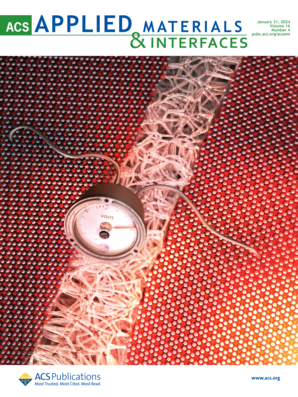非球形纳米颗粒在有序嵌段共聚物中的取向研究
IF 8.3
2区 材料科学
Q1 MATERIALS SCIENCE, MULTIDISCIPLINARY
引用次数: 0
摘要
在可控催化、电磁场操纵和纳米科学等领域,介导自组装已成为控制非球形纳米颗粒取向的关键方法。嵌段共聚物自组装形成的有序结构可以为非球形纳米颗粒提供取向基质。基于自一致场理论,研究了单轴对称圆柱形纳米颗粒在嵌段共聚物层状相中的取向效应。采用圆柱形和含孔环状纳米粒子作为非球形粒子的模型,成功地描述了颗粒的各向异性和非凸表面性质。数值结果表明,层状有序结构的取向效应对非球形粒子的几何和拓扑性质具有重要的依赖关系。除界面张力作用外,小粒径纳米颗粒的取向机制主要来自于聚合物的拉伸作用,主要表现为两种作用:(1)颗粒使聚合物链变形,使其构象熵降低,趋向于特定取向排列;(2)聚合物链端取向场不连续,纳米颗粒可以嵌入并采用特定取向。对于非凸纳米颗粒,孔结构的几何尺寸调节聚合物的自由体积,影响取向效应。该研究不仅加深了对嵌段共聚物介导的纳米粒子自组装取向机制的理解,而且为能量催化、生物医学材料和功能纳米结构的设计和应用提供了潜在的理论见解。本文章由计算机程序翻译,如有差异,请以英文原文为准。

Orientation of Nonspherical Nanoparticles in Ordered Block Copolymer for Functional Materials
In the fields of controllable catalysis, electromagnetic field manipulation, and nanoscience, mediated self-assembly has become a key method for controlling the orientation of nonspherical nanoparticles. The ordered structures formed by block copolymer self-assembly can provide an orientation matrix for nonspherical nanoparticles. Based on self-consistent field theory, this study investigates the orientation effects of monaxially symmetric cylindrical nanoparticles in the lamellar phases formed by block copolymers. Using cylindrical and pore-containing ring nanoparticles as models for nonspherical particles, we successfully describe the particles’ anisotropy and nonconvex surface properties. Numerical results show that the orientation effect of the lamellar ordered structure exhibits a nontrivial dependence on the geometric and topological properties of nonspherical particles. In addition to interfacial tension effects, the orientation mechanism of small-sized nanoparticles mainly arises from the stretching effect of the polymer, manifested in two main effects: (1) the particle deforms the polymer chain, reducing its conformational entropy, thus tending to align in a specific orientation; (2) the orientation field at the polymer chain ends is discontinuous, and the nanoparticles can embed and adopt a specific orientation. For nonconvex nanoparticles, the geometric size of the pore structure adjusts the polymer’s free volume, influencing the orientation effect. This study not only deepens the understanding of the orientation mechanism in block copolymer-mediated nanoparticle self-assembly, but also provides potential theoretical insights for the design and application of energy catalysis, biomedical materials, and functional nanostructures.
求助全文
通过发布文献求助,成功后即可免费获取论文全文。
去求助
来源期刊

ACS Applied Materials & Interfaces
工程技术-材料科学:综合
CiteScore
16.00
自引率
6.30%
发文量
4978
审稿时长
1.8 months
期刊介绍:
ACS Applied Materials & Interfaces is a leading interdisciplinary journal that brings together chemists, engineers, physicists, and biologists to explore the development and utilization of newly-discovered materials and interfacial processes for specific applications. Our journal has experienced remarkable growth since its establishment in 2009, both in terms of the number of articles published and the impact of the research showcased. We are proud to foster a truly global community, with the majority of published articles originating from outside the United States, reflecting the rapid growth of applied research worldwide.
 求助内容:
求助内容: 应助结果提醒方式:
应助结果提醒方式:


